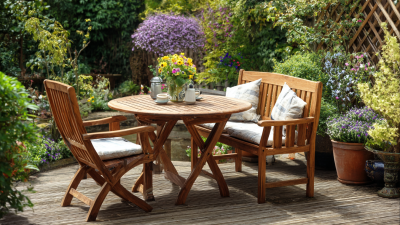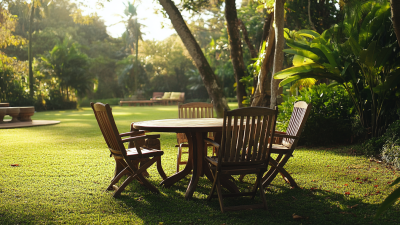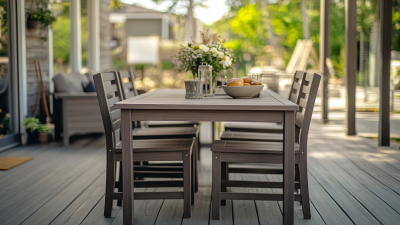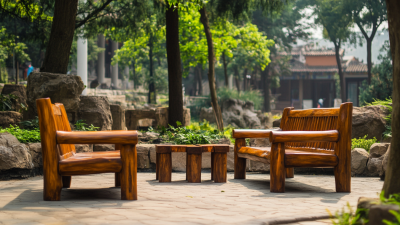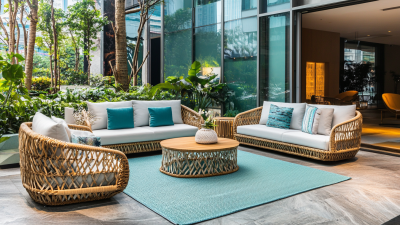Enhance Your Outdoor Space with Sustainable Wooden Garden Furniture Choices
As the focus on sustainable living continues to grow, the demand for eco-friendly solutions in our outdoor spaces is increasingly significant. Wooden garden furniture has emerged as a popular choice among environmentally-conscious consumers, with the global garden furniture market projected to reach $24.5 billion by 2027, as per a recent report by Grand View Research. This surge is attributed not only to the aesthetic appeal of wooden pieces but also to their durability and minimal environmental footprint when sourced sustainably. According to the Forest Stewardship Council (FSC), sustainably sourced timber can positively impact local ecosystems and communities, enhancing the overall appeal of wooden garden furniture. By choosing high-quality, sustainable options, homeowners can create inviting and responsible outdoor environments that reflect their commitment to ecological stewardship while enjoying the beauty and charm that wooden furnishings bring to their gardens.

Sustainable Materials: Why Choose Certified Wood for Outdoor Furniture
When it comes to enhancing your outdoor space, choosing sustainable materials is essential, particularly when selecting wooden garden furniture. Certified wood, sourced from responsibly managed forests, not only supports environmental conservation but also ensures that your furniture is built to last. By opting for such materials, you contribute to reducing deforestation and promoting biodiversity, making a positive impact on the planet.
Tips: Look for certifications like FSC (Forest Stewardship Council) or PEFC (Programme for the Endorsement of Forest Certification) when shopping for wooden furniture. These labels guarantee that the wood has been sourced sustainably, providing you with peace of mind regarding the environmental footprint of your purchase. Additionally, consider furniture made from reclaimed wood, which adds character while minimizing waste.
Incorporating sustainable wooden furniture into your garden isn't just about the choice of material; it’s also about how to maintain it responsibly. Regularly treating your wooden pieces with natural oils can preserve their beauty and longevity without environmentally harmful chemicals. Building your outdoor space with care for nature will create a relaxing retreat that reflects your values while enhancing the beauty of your surroundings.
Top Five Durable Wood Species for Garden Furniture and Their Sustainability Ratings
When it comes to enhancing your outdoor space, selecting the right wooden garden furniture is crucial, especially if sustainability is a priority. The choice of wood species plays a significant role in both durability and environmental impact. Here are five top wood species known for their resilience and sustainability ratings.
Teak is a standout choice, renowned for its longevity and natural resistance to decay and insects. Its dense grain not only adds beauty but also ensures minimal maintenance over the years. Another excellent option is eucalyptus, which offers a strong alternative to teak at a more affordable price. Eucalyptus is also fast-growing, making it a sustainable choice when sourced from responsibly managed forests. Additionally, black locust is celebrated for its extreme durability and natural resistance to rot, while being incredibly eco-friendly as it is often sourced from local supplies in the U.S.
Lastly, consider acacia wood, valued for its striking appearance and versatility. This hardwood is not only durable but also comes from sustainable plantations, making it a smart and environmentally conscious choice for your garden furniture. By opting for these wood species, you can create a stunning outdoor space while making a positive impact on the environment.
Enhance Your Outdoor Space with Sustainable Wooden Garden Furniture Choices - Top Five Durable Wood Species for Garden Furniture and Their Sustainability Ratings
| Wood Species |
Durability (Years) |
Sustainability Rating |
Resistance to Weather |
Typical Uses |
| Teak |
50+ |
A |
Excellent |
Outdoor Furniture, Decking |
| Ipe |
40+ |
B |
Good |
Decking, Furniture |
| Cedar |
20+ |
A- |
Good |
Fencing, Furniture |
| Redwood |
25+ |
B+ |
Excellent |
Furniture, Garden Structures |
| Acacia |
15+ |
B |
Good |
Outdoor Furniture, Indoor Use |
Enhancing Outdoor Aesthetics: The Role of Design in Sustainable Garden Furniture
 Sustainable garden furniture is increasingly becoming a focal point for outdoor design enthusiasts. With the global furniture market projected to reach $650 billion by 2024, the demand for eco-friendly options is rising. According to a 2021 report by the World Wildlife Fund (WWF), wooden furniture sourced from responsibly managed forests reduces deforestation impact and contributes to a healthier environment. Design plays a critical role in leveraging these materials for optimal aesthetic appeal, allowing homeowners to create visually striking outdoor spaces that align with sustainability goals.
Sustainable garden furniture is increasingly becoming a focal point for outdoor design enthusiasts. With the global furniture market projected to reach $650 billion by 2024, the demand for eco-friendly options is rising. According to a 2021 report by the World Wildlife Fund (WWF), wooden furniture sourced from responsibly managed forests reduces deforestation impact and contributes to a healthier environment. Design plays a critical role in leveraging these materials for optimal aesthetic appeal, allowing homeowners to create visually striking outdoor spaces that align with sustainability goals.
When selecting sustainable wooden furniture, consider the wood species and its durability. Teak and eucalyptus, for example, are not only long-lasting but also come from renewable sources. Tips for enhancing your outdoor aesthetics include mixing textures, such as pairing sleek wooden tables with soft outdoor cushions, and opting for darker wood finishes that contrast beautifully with the greenery of your garden.
Additionally, be mindful of your furniture’s design. Pieces that are modular or multi-functional can maximize space and versatility, making your outdoor area both stylish and practical. Investing in sustainable furniture is an investment in the long-term beauty of your outdoor space, supporting both environmental responsibility and aesthetic enrichment.
Maintenance Tips: Prolonging the Life of Your Wooden Garden Furniture
Choosing sustainable wooden garden furniture is an excellent way to enhance your outdoor space aesthetically and environmentally. While the initial purchase is crucial, proper maintenance is key to prolonging the life of your wooden pieces. According to the Forest Stewardship Council (FSC), sustainably sourced wood can last significantly longer than untreated materials, reducing the need for frequent replacements and minimizing environmental impact.
To ensure your wooden garden furniture remains in top condition, regular cleaning is essential. Aim to clean your furniture every few months using mild soap and water to remove dirt and grime. Additionally, applying a protective sealant or oil can help guard against moisture and UV damage, which can lead to warping and fading. As noted in a report by the American Wood Council, maintaining a good finish can extend the life of wooden outdoor furniture by up to 40%, making this a worthwhile investment of time and resources.
Furthermore, it’s important to store your furniture properly during the off-season. When not in use, consider covering your pieces or storing them in a shaded area to protect against the elements. According to the National Association of Home Builders, proper care and storage practices can enhance the longevity of your outdoor items by several years, which is critical for sustainable living. Employing these tips will not only preserve the beauty of your garden furniture but also contribute to a more sustainable lifestyle.
Economic Benefits: Cost Savings from Investing in Sustainable Outdoor Furniture Options
Investing in sustainable wooden garden furniture not only enhances your outdoor space but also brings notable economic benefits. According to a report by the International Institute for Sustainable Development, sustainable furniture options can save homeowners up to 20% on maintenance costs over a decade. This is primarily due to the durability of sustainably sourced woods, which are treated and processed in environmentally responsible ways. Unlike conventional furniture, which may require frequent replacements, sustainable pieces provide longevity that translates into significant cost savings.
Moreover, the global market for sustainable furniture is projected to grow at a compound annual growth rate (CAGR) of 8.5% from 2023 to 2030, as stated in a recent report by Research and Markets. This upward trend indicates a rising consumer preference for eco-friendly products, which often come with warranties and assurances of quality. By choosing sustainable wooden furniture, homeowners not only contribute to environmental conservation but also benefit from the increased resale value of their properties, with studies showing that houses with sustainable features can sell up to 10% more than those without.

Home
About Us
Products
Engineering Case
Buyer Service
News
Blog
Contact Us



 Sustainable garden furniture is increasingly becoming a focal point for outdoor design enthusiasts. With the global furniture market projected to reach
Sustainable garden furniture is increasingly becoming a focal point for outdoor design enthusiasts. With the global furniture market projected to reach 
